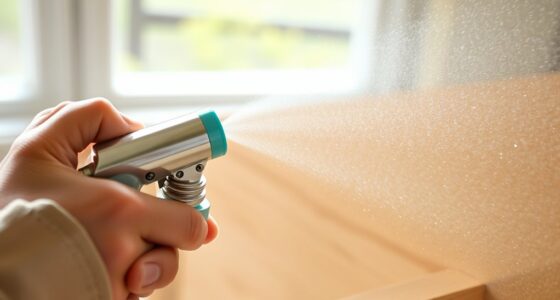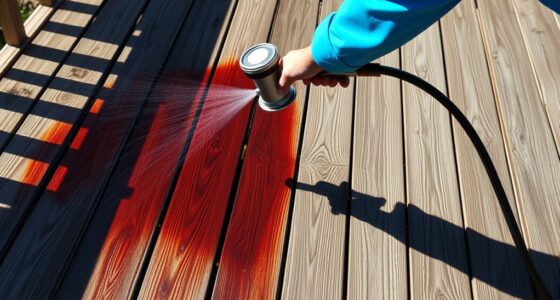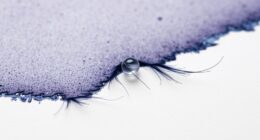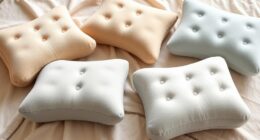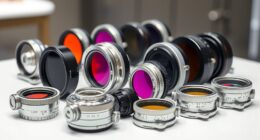Using a paint sprayer for mist coating and priming new drywall helps you achieve quick, even coverage and a professional finish. Adjust the sprayer settings for proper pressure and thicker primer, and hold the gun about 12 inches from the surface. Apply light coats with steady, overlapping passes, ensuring each layer dries thoroughly before the next. Proper maintenance of your sprayer and preparation tips will guide you toward flawless drywall prep—more details await if you keep exploring.
Key Takeaways
- Use a paint sprayer to quickly and evenly apply primer and mist coats on new drywall surfaces.
- Adjust spray gun settings for optimal pressure and flow, thinning primer if needed for smooth application.
- Maintain consistent spray patterns with slight overlaps to ensure full, even coverage and proper sealing.
- Clean and maintain the spray gun regularly to prevent clogs and ensure a professional finish.
- Confirm primer is fully dry before applying topcoats for a strong, smooth drywall foundation.
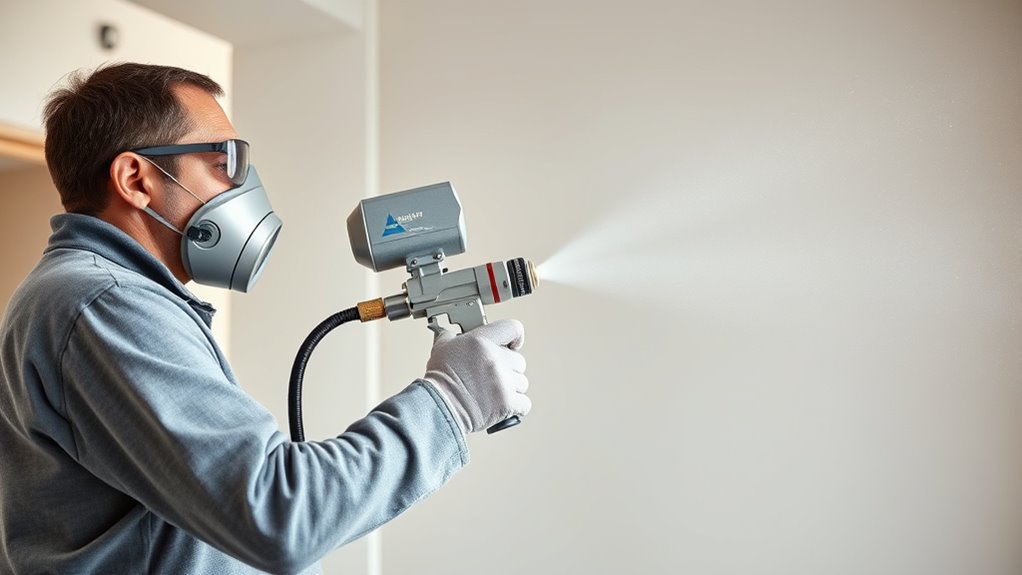
If you’re looking to achieve a smooth, professional finish on drywall, a paint sprayer can be your best tool. One of the most important steps in preparing new drywall is applying a primer coat, often called a mist coat. Using a paint sprayer makes primer application faster and more even, ensuring the surface is properly sealed before painting. To get the best results, focus on how you set up your spray gun, maintain it properly, and control your spray pattern. Proper spray gun maintenance prevents clogging and ensures consistent spray, which is crucial for a flawless finish. Always clean your spray gun thoroughly after each use, paying close attention to the nozzle and filters, so they stay free of dried paint or debris. Regular maintenance reduces downtime and prolongs your equipment’s lifespan, making future projects easier. Additionally, understanding the benefits of airless paint sprayers can help you optimize your workflow and achieve superior results more efficiently. When applying primer, start by checking your spray gun’s adjustments. Adjust the pressure and flow rate to match the primer’s consistency and the drywall surface. Thin the primer if necessary, following the manufacturer’s instructions, to ensure it sprays smoothly without clogging. Hold the spray gun at a consistent distance—usually around 12 inches—from the wall, and move steadily across the surface to avoid drips or uneven coverage. Overlapping each pass slightly helps achieve an even coat, which is essential for a uniform finish once the paint is applied. Remember, a mist coat is usually thin and lightly tinted to help identify missed spots or uneven areas. It’s better to do multiple light coats than one heavy application, which can cause runs or sags. Throughout the process, pay close attention to spray gun maintenance. Regularly check the nozzle for clogs or damage and replace worn parts promptly. Clean the spray gun immediately after finishing, flushing out all residual primer with an appropriate solvent or water, depending on the primer type. Proper cleaning prevents buildup that can affect spray patterns and spray gun longevity. When you’re ready to switch to the topcoat, make sure the primer is fully dry, which typically takes a few hours. This preparation step ensures the topcoat bonds well and results in a smooth, professional-looking finish. By focusing on meticulous primer application and diligent spray gun maintenance, you’ll set a solid foundation for the entire painting project, saving time and achieving superior results.
Frequently Asked Questions
Can I Use a Paint Sprayer for Textured Drywall Finishes?
You can definitely use a paint sprayer for textured drywall finishes. It provides even coverage and allows you to create a variety of textured finishes with different spray techniques. Just make certain you choose the right nozzle and pressure settings for your desired texture. Practice on a scrap piece first to perfect your technique. With proper preparation and technique, a spray gun can give you a professional-looking textured finish efficiently.
What Safety Precautions Are Necessary When Using a Paint Sprayer?
When using a paint sprayer, prioritize safety by wearing protective gear, including masks, goggles, and gloves, to shield yourself from fumes and overspray. Make certain good ventilation practices are in place—open windows, use fans, and work outdoors if possible—to prevent inhaling harmful particles. Always read the manufacturer’s instructions, keep your workspace clean, and avoid skin contact with chemicals. These precautions protect your health and ensure a safe, successful painting project.
How Do I Clean and Maintain the Paint Sprayer After Use?
To keep your paint sprayer in top shape, follow regular cleaning tips and stick to a maintenance schedule. After each use, flush the system with water or solvent, depending on your paint type. Disassemble parts carefully, clean all components thoroughly, and dry them before reassembling. Regular maintenance prolongs your sprayer’s lifespan and ensures smooth operation, saving you time and effort on future projects.
Is a Paint Sprayer Suitable for Small Drywall Repairs?
Your drywall repair deserves perfection, and a paint sprayer can be just the tool to make it shine! For small repairs, it’s suitable—saving you time and achieving a smooth finish. Just remember, mastering brush techniques and ensuring the right paint consistency are key. A sprayer offers precision and speed, but for tiny spots, careful control is essential. With patience, you’ll get professional results in no time!
What Types of Paint Are Best for Spray Application on Drywall?
When choosing paint for spray application on drywall, you want a paint with the right consistency—thinner paints work best for smooth, even coverage. Opt for latex or acrylic paints, as they’re compatible with most sprayers and provide good adhesion. Always check your sprayer’s compatibility and adjust the paint’s consistency if needed, ensuring it flows well without clogging the equipment. This approach helps you achieve a professional finish efficiently.
Conclusion
Don’t let the fear of mess or complexity hold you back. Using a paint sprayer for mist coat and primer makes drywall prep faster, easier, and more even. Imagine stepping back to see a flawless surface ready for your finish coat—proud of your work. Even if you’re new to spraying, with a little patience, you’ll transform your space and gain confidence in your DIY skills. Trust the process—you’ll love the professional results.
Franz came aboard the Paint Sprayer Zone team with a background in both journalism and home renovation. His articulate writing style, combined with a passion for DIY projects, makes him an invaluable asset. Franz has a knack for breaking down technical jargon into easy-to-understand content, ensuring that even the most novice of readers can grasp the complexities of paint sprayers.





